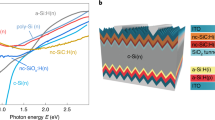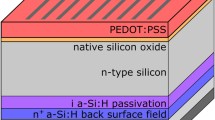Abstract
The introduction of dopant-free materials used for carrier-selective contact effectively overcomes the issue of high surface recombination velocity at aluminum back surface field. Additionally, dopant-free materials have the advantages of low fabrication temperature, simple process and considerably high efficiency. In this contribution, cuprous sulfide (Cu2S), fabricated by thermal evaporation, is applied as hole-selective contact material at rear-surface region of crystalline silicon (c-Si) solar cells for the first time. The band alignment of Cu2S/p-Si exhibits only a small valence band offset and huge conduction band offset being excellent hole-selective and electron blocking properties. By inserting Cu2S layer between p-Si and Ag, a lower contact resistivity of 27.2 mΩ cm2 is achieved. As a result, the introduction with 4-nm Cu2S interlayer significantly improves device efficiency to over 21%, affording a 1.2% absolute increase from the control cell. Metal sulfides introduced herein exhibit remarkable properties for carrier-selective contacts, compared to conventional metal nitrides and oxides.







Similar content being viewed by others
References
Green MA (2009) The path to 25% silicon solar cell efficiency: history of silicon cell evolution. Prog Photovolt Res Appl 17:183–189
Battaglia C, Cuevas A, De Wolf S (2016) High-efficiency crystalline silicon solar cells: status and perspectives. Energy Environ Sci 9:1552–1576
Yoshikawa K, Kawasaki H, Yoshida W et al (2017) Silicon heterojunction solar cell with interdigitated back contacts for a photoconversion efficiency over 26%. Nat Energy 2:17032
Bullock J, Hettick M, Geissbühler J et al (2016) Efficient silicon solar cells with dopant-free asymmetric heterocontacts. Nat Energy 1:15031
Battaglia C, Yin X, Zheng M et al (2014) Hole selective MoOx contact for silicon solar cells. Nano Lett 14:967–971
Bullock J, Cuevas A, Allen T, Battaglia C (2014) Molybdenum oxide MoOx: a versatile hole contact for silicon solar cells. Appl Phys Lett 105:232109
Bullock J, Zheng P, Jeangros Q et al (2016) Lithium fluoride based electron contacts for high efficiency n-type crystalline silicon solar cells. Adv Energy Mater 6:1600241
Yang X, Aydin E, Xu H et al (2018) Tantalum nitride electron-selective contact for crystalline silicon solar cells. Adv Energy Mater 8:1800608
Geissbühler J, Werner J, Martin de Nicolas S et al (2015) 22.5% efficient silicon heterojunction solar cell with molybdenum oxide hole collector. Appl Phys Lett 107:081601
Glunz SW, Feldmann F (2018) SiO2 surface passivation layers—a key technology for silicon solar cells. Sol Energy Mater Sol Cells 185:260–269
Quan C, Tong H, Yang Z et al (2018) Electron-selective scandium-tunnel oxide passivated contact for n-type silicon solar cells. Solar RRL 2:1800071
Wan Y, Karuturi SK, Samundsett C et al (2017) Tantalum oxide electron-selective heterocontacts for silicon photovoltaics and photoelectrochemical water reduction. ACS Energy Lett 3:125–131
Melskens J, van de Loo BWH, Macco B, Black LE, Smit S, Kessels WMM (2018) Passivating contacts for crystalline silicon solar cells: from concepts and materials to prospects. IEEE J Photovolt 8:373–388
Feldmann F, Simon M, Bivour M, Reichel C, Hermle M, Glunz SW (2014) Efficient carrier-selective p- and n-contacts for Si solar cells. Sol Energy Mater Sol Cells 131:100–104
Yang X, Zheng P, Bi Q, Weber K (2016) Silicon heterojunction solar cells with electron selective TiOx contact. Sol Energy Mater Sol Cells 150:32–38
Lin L, Gu C, Zhu J et al (2019) Engineering of hole-selective contact for high-performance perovskite solar cell featuring silver back-electrode. J Mater Sci 54:7789–7797. https://doi.org/10.1007/s10853-018-03258-x
Wan Y, Samundsett C, Bullock J et al (2016) Magnesium fluoride electron-selective contacts for crystalline silicon solar cells. ACS Appl Mater Interfaces 8:14671–14677
Allen TG, Bullock J, Zheng P et al (2017) Calcium contacts to n-type crystalline silicon solar cells. Prog Photovolt Res Appl 25:636–644
Allen TG, Bullock J, Jeangros Q et al (2017) A low resistance calcium/reduced titania passivated contact for high efficiency crystalline silicon solar cells. Adv Energy Mater 7:1602606
Feldmann F, Ritzau K-U, Bivour M et al (2015) High and low work function materials for passivated contacts. Energy Proc 77:263–270
Lin W, Wu W, Liu Z et al (2018) Chromium trioxide hole-selective heterocontacts for silicon solar cells. ACS Appl Mater Interfaces 10:13645–13651
Bivour M, Temmler J, Steinkemper H, Hermle M (2015) Molybdenum and tungsten oxide: high work function wide band gap contact materials for hole selective contacts of silicon solar cells. Sol Energy Mater Sol Cells 142:34–41
Tong J, Wan Y, Cui J, Lim S, Song N, Lennon A (2017) Solution-processed molybdenum oxide for hole-selective contacts on crystalline silicon solar cells. Appl Surf Sci 423:139–146
Zhang X, Wan Y, Bullock J, Allen T, Cuevas A (2016) Low resistance Ohmic contact to p-type crystalline silicon via nitrogen-doped copper oxide films. Appl Phys Lett 109:052102
Gao P, Yang Z, He J et al (2018) Dopant-free and carrier-selective heterocontacts for silicon solar cells: recent advances and perspectives. Adv Sci 5:1700547
Lin W, Wu W, Xie Q et al (2018) Conductive cuprous iodide hole-selective contacts with thermal and ambient stability for silicon solar cells. ACS Appl Mater Interfaces 10:43699–43706
Cai L, Wang W, Jin L et al (2019) 12.29% Low temperature-processed dopant-free CdS/p-Si heterojunction solar cells. Adv Mater Interfaces. https://doi.org/10.1002/admi.201900367
Parreira P, Lavareda G, Amaral A et al (2011) Transparent p-type CuxS thin films. J Alloys Compd 509:5099–5104
Huang A, He Y, Zhou Y et al (2018) A review of recent applications of porous metals and metal oxide in energy storage, sensing and catalysis. J Mater Sci 54:949–973. https://doi.org/10.1007/s10853-018-2961-5
Martinson ABF, Riha SC, Thimsen E, Elam JW, Pellin MJ (2013) Structural, optical, and electronic stability of copper sulfide thin films grown by atomic layer deposition. Energy Environ Sci 6:1868
Zhang Y, Wang Y, Xi L et al (2014) Electronic structure of antifluorite Cu2x (X = S, Se, Te) within the modified Becke–Johnson potential plus an on-site Coulomb U. J Chem Phys 140:074702
Riha SC, Jin S, Baryshev SV, Thimsen E, Wiederrecht GP, Martinson AB (2013) Stabilizing Cu2S for photovoltaics one atomic layer at a time. ACS Appl Mater Interfaces 5:10302–10309
Jiang Y, Zhang X, Ge QQ et al (2014) Engineering the interfaces of ITO@Cu2S nanowire arrays toward efficient and stable counter electrodes for quantum-dot-sensitized solar cells. ACS Appl Mater Interfaces 6:15448–15455
Fu H (2018) Environmentally friendly and earth-abundant colloidal chalcogenide nanocrystals for photovoltaic applications. J Mater Chem C 6:414–445
Sharma R, Cai G, Shinde DV et al (2014) Polyelectrolyte multilayer-assisted fabrication of p-Cu2S/n-CdS heterostructured thin-film phototransistors. J Mater Chem C 2:8012–8017
Zhang C, Tao J, Chu J (2018) An 8.7% efficiency co-electrodeposited Cu2ZnSnS4 photovoltaic device fabricated via a pressurized post-sulfurization process. J Mater Chem C 6:13275–13282
Tang A, Teng F, Wang Y et al (2008) Investigation on photovoltaic performance based on matchstick-like Cu(2)S–In(2)S(3) heterostructure nanocrystals and polymer. Nanoscale Res Lett 3:502–507
Türck J, Siol S, Mayer T, Klein A, Jaegermann W (2015) Cu2S as ohmic back contact for CdTe solar cells. Thin Solid Films 582:336–339
Hall R, Birkmire R, Phillips J, Meakin J (1981) Thin-film polycrystalline Cu2S/Cd1−x ZnxS solar cells of 10% efficiency. Appl Phys Lett 38:925–926
Sam M, Bayati MR, Mojtahedi M, Janghorban K (2010) Growth of Cu2S/CdS nano-layered photovoltaic junctions for solar cell applications. Appl Surf Sci 257:1449–1453
Norian KH, Hall RB (1982) Fabrication and characterization of stable high efficiency (Cd, Zn)S/Cu2S solar cells. Thin Solid Films 88:55–66
Bryant FJ, Hariri AK, Scott CG (1983) Surface and interface processes influencing the stability of Cu2S–CdS thin film solar cells. J Phys D Appl Phys 16:2341–2348
Agbenyeke RE, Park BK, Chung T-M, Kim CG, Han JH (2018) Growth of Cu2S thin films by atomic layer deposition using Cu(dmamb)2 and H2S. Appl Surf Sci 456:501–506
Chen SG, Huang YF, Liu YQ, Xia Q, Liao HW, Long CG (2008) Synthesis and characterization of cuprous sulfide crystals with novel morphology. Mater Lett 62:2503–2506
Pi P, Hou K, Zhou C et al (2017) Superhydrophobic Cu2S@Cu2O film on copper surface fabricated by a facile chemical bath deposition method and its application in oil–water separation. Appl Surf Sci 396:566–573
Liu D, Liu J, Liu J et al (2018) The effect of CuS counter electrodes for the CdS/CdSe quantum dot co-sensitized solar cells based on zinc titanium mixed metal oxides. J Mater Sci 54:4884–4892. https://doi.org/10.1007/s10853-018-03203-y
More P, Dhanayat S, Gattu K, Mahajan S, Upadhye D, Sharma R (2016) Annealing effect on Cu2S thin films prepared by chemical bath deposition. AIP Conf Proc 1728:020489
Isac L, Duta A, Kriza A, Manolache S, Nanu M (2007) Copper sulfides obtained by spray pyrolysis-possible absorbers in solid-state solar cells. Thin Solid Films 515:5755–5758
Zhuge F, Li X, Gao X, Gan X, Zhou F (2009) Synthesis of stable amorphous Cu2S thin film by successive ion layer adsorption and reaction method. Mater Lett 63:652–654
Siol S, Sträter H, Brüggemann R et al (2013) PVD of copper sulfide (Cu2S) for PIN-structured solar cells. J Phys D Appl Phys 46:495112
Zhao Y, Chen K, Zhong Q, Yang S, Liu Y (2017) Single sub-microwire solar cells based on the CdS–Cu2S and CdS–ZnS core–shell heterostructures. Prog Nat Sci Mater Int 27:182–185
Cox R, Strack H (1967) Ohmic contacts for GaAs devices. Solid State Electron 10:1213–1218
Krylova V, Andrulevičius M (2009) Optical, XPS and XRD studies of semiconducting copper sulfide layers on a polyamide film. Int J Photoenergy 2009:1–8
Aria AI, Kidambi PR, Weatherup RS, Xiao L, Williams JA, Hofmann S (2016) Time evolution of the wettability of supported graphene under ambient air exposure. J Phys Chem C 120:2215–2224
Ma J, Du Q, Ge H, Zhang Q (2018) Fabrication of core–shell TiO2@CuS nanocomposite via a bifunctional linker-assisted synthesis and its photocatalytic performance. J Mater Sci 54:2928–2939. https://doi.org/10.1007/s10853-018-3054-1
Ghazzal MN, Wojcieszak R, Raj G, Gaigneaux EM (2014) Study of mesoporous CdS-quantum-dot-sensitized TiO2 films by using X-ray photoelectron spectroscopy and AFM. Beil J Nanotechnol 5:68
Gupta S, Batra Y, Mehta BR, Satsangi VR (2013) Study of charge separation and interface formation in a single nanorod CdS–Cu(x)S heterojunction solar cell using Kelvin probe force microscopy. Nanotechnology 24:255703
Acknowledgements
This work was funded by National Natural Science Foundation (NSF) of China (Grant Nos. 61774171, 61774173). The author would like to acknowledge CETC-48 Institution for their help with silicon fabrication process. L. Jin would like to thank Wenjie Lin for technical assistance with contact resistivity measurement.
Author information
Authors and Affiliations
Corresponding authors
Ethics declarations
Conflict of interest
All authors declare that they have no conflict of interest.
Additional information
Publisher's Note
Springer Nature remains neutral with regard to jurisdictional claims in published maps and institutional affiliations.
Electronic supplementary material
Below is the link to the electronic supplementary material.
Rights and permissions
About this article
Cite this article
Jin, L., Cai, L., Chen, D. et al. Efficient silicon solar cells applying cuprous sulfide as hole-selective contact. J Mater Sci 54, 12650–12658 (2019). https://doi.org/10.1007/s10853-019-03797-x
Received:
Accepted:
Published:
Issue Date:
DOI: https://doi.org/10.1007/s10853-019-03797-x




